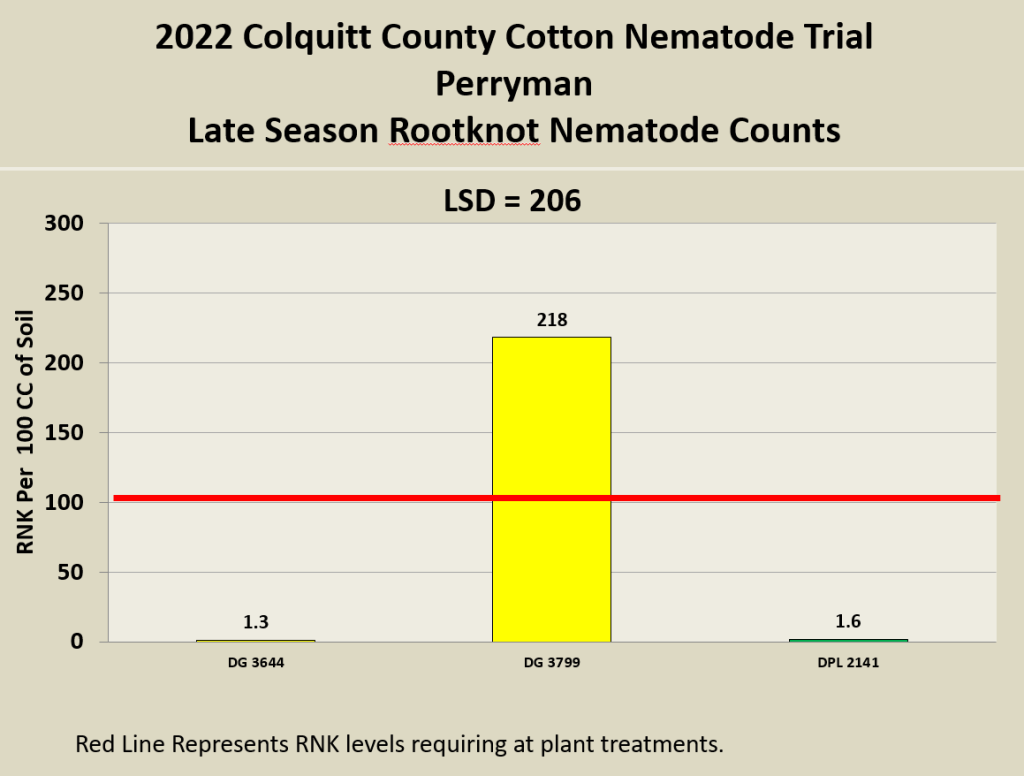Below are the results of two on-farm cotton demonstrations conducted in Colquitt County in 2022. The first demonstration evaluated different cotton fungicide treatments. The second demonstration evaluated how two nematode-resistant cotton varieties and one non-resistant variety performed in a field with a history of root knot nematodes.
2022 Colquitt County Cotton Fungicide Demonstration
This past year, a cotton fungicide demonstration was conducted in Colquitt County to evaluate how fungicides can used to manage areolate mildew. The treatments included Abound (6 oz/A), Revytek (10oz/A), Syngenta Experimental and an untreated check. The treatments were applied during the 3rd week of bloom in a field that had a history of areolate mildew and was replicated 3 times. Each plot was 18 rows wide and ran the length of the field. The cotton variety planted in this field was DG 3615 B3XF.

The treatments were rated by Dr. Bob Kemerait, UGA Plant Pathologist for disease incidence and canopy defoliation at 26 and 54 days after treatment (DAT). Target spot was not noticed in the plots at 26 and 54 DAT. No significant differences were noted for areolate mildew incidence among treatments, but all fungicide treatments numerically reduced incidence from 35 percent to 10.6-15 percent at 54 DAT.

At 26 DAT, Dr. Bob noticed no defoliation among all the treatments. At 56 DAT, low defoliation was noticed among treatments ranging from 3 to 18 percent. All fungicides significantly lowered the amount of defoliation compared to the untreated check.

Yields are reported in the slide below, and they show no significant differences in yield among treatments.

Colquitt County Cotton Nematode Variety Evaluation.
Southern root knot nematode, Meloidogyne incognita, is production issue we face in Colquitt County. An effective tactic to manage either of these plant parasitic nematodes in cotton production is to plant resistant varieties. Cotton producers in Georgia have the opportunity to plant a number of different varieties that have resistance to the southern root-knot nematode.
This past year a field demonstration was planted in a Colquitt County field that had a history of southern root-knot nematode. Three cotton varieties were planted in this field demonstration which included DPL 2141 B3XF, Dyna-Gro 3644 B3XF and Dyna-Gro 3799 B3XF. DPL 2141 B3XF and Dyna-Gro 3644 B3XF have resistance to southern root-knot and reniform nematodes. The non-resistant variety used in this field trial was Dyna-Gro 3799 B3XF.
This plot was planted on May 23, 2022. Each treatment was six rows wide by the length of the field and was replicated three times. Aglogic (3.5 lb/A) was used for thrips control for all treatments. The plots were harvested on November 21, 2022. Post-harvest nematode samples were taken to determine nematode levels. The red line represents the postharvest root-knot nematode threshold for cotton, which is 100 RNK per 100 ccs of soil. The results show DG 3799 was above the post-harvest threshold and had a significantly higher population of RNK compared to the nematode-resistant varieties.

The illustration below shows yields from the plots. There were no significant differences in yields among treatments, but there were numerical differences. The DPL 2141 had the highest yield (1102 lb/A) and the DG 3644 had the lowest yield in this field demonstration. The green columns indicate the varieties were nematode-resistant, and the yellow column indicates a nematode susceptible variety.

